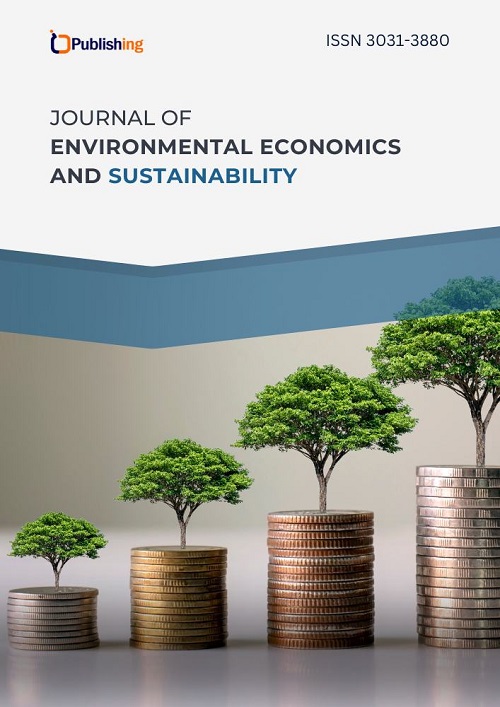Specific Features and Ecological Significance of Mosses
DOI:
https://doi.org/10.47134/jees.v2i2.635Keywords:
mosses, Bryophyta, lower plants, ecology, bioindicator, biopolymersAbstract
This article examines the role of mosses (Bryophyta) in the ecological system, their chemical composition, and potential uses. The main goal of the research is to determine the role of mosses in ensuring environmental sustainability and to assess the possibilities of their use as bioindicators. Methodologically, methods of literature analysis, empirical research, laboratory experiments, and statistical analysis were used. The research results showed the influence of mosses on soil formation, moisture retention properties, and the possibility of their use in industry. The practical significance lies in the fact that mosses can be used as bioindicators in environmental monitoring systems, as well as in the fields of pharmaceuticals and biotechnology.
References
Baxendale, C.L. (2016). Can digital image classification be used as a standardised method for surveying peatland vegetation cover? Ecological Indicators, 68, 150-156, ISSN 1470-160X, https://doi.org/10.1016/j.ecolind.2015.11.035 DOI: https://doi.org/10.1016/j.ecolind.2015.11.035
Bhusal, D.R. (2015). Temperature-based bioclimatic parameters can predict nematode metabolic footprints. Oecologia, 179(1), 187-199, ISSN 0029-8549, https://doi.org/10.1007/s00442-015-3316-4 DOI: https://doi.org/10.1007/s00442-015-3316-4
Fernández-Martínez, M. (2019). Towards a moss sclerophylly continuum: Evolutionary history, water chemistry and climate control traits of hygrophytic mosses. Functional Ecology, 33(12), 2273-2289, ISSN 0269-8463, https://doi.org/10.1111/1365-2435.13443 DOI: https://doi.org/10.1111/1365-2435.13443
Gao, J. (2016). Geographical distribution pattern of endemic bryophytes in China. Chinese Journal of Ecology, 35(7), 1691-1696, ISSN 1000-4890, https://doi.org/10.13292/j.1000-4890.201607.035
Gignac, L. D. (2001). Bryophytes as indicators of climate change. Biological Conservation, 12(2), 45-56.
Glime, J. M. (2007). Bryophyte Ecology. Michigan Technological University Press.
Hintz, L. (2021). Vegetation dynamics under residual large trees following a volcanic eruption in a Valdivian temperate rainforest. Plant Ecology, 222(8), 915-931, ISSN 1385-0237, https://doi.org/10.1007/s11258-021-01151-3 DOI: https://doi.org/10.1007/s11258-021-01151-3
Johnson, M.G. (2015). Genetic diversity, sexual condition, and microhabitat preference determine mating patterns in Sphagnum (Sphagnaceae) peat-mosses. Biological Journal of the Linnean Society, 115(1), 96-113, ISSN 0024-4066, https://doi.org/10.1111/bij.12497 DOI: https://doi.org/10.1111/bij.12497
Jones, S., & Carter, M. (2011). The role of bryophytes in forest ecosystems. Forest Ecology and Management, 263(1), 24-32.
Lönnell, N. (2018). Calcicolous plants colonize limed mires after long-distance dispersal. Journal of Biogeography, 45(4), 885-894, ISSN 0305-0270, https://doi.org/10.1111/jbi.13180 DOI: https://doi.org/10.1111/jbi.13180
Markle, C.E. (2020). Initial Effects of Wildfire on Freshwater Turtle Nesting Habitat. Journal of Wildlife Management, 84(7), 1373-1383, ISSN 0022-541X, https://doi.org/10.1002/jwmg.21921 DOI: https://doi.org/10.1002/jwmg.21921
Monforte, L. (2018). Cell compartmentation of ultraviolet-absorbing compounds: An underexplored tool related to bryophyte ecology, phylogeny and evolution. Functional Ecology, 32(4), 882-893, ISSN 0269-8463, https://doi.org/10.1111/1365-2435.13048 DOI: https://doi.org/10.1111/1365-2435.13048
Rydin, H., & Jeglum, J. K. (2013). The biology of peatlands. Oxford University Press. DOI: https://doi.org/10.1093/acprof:osobl/9780199602995.001.0001
Sand-Jensen, K. (2017). Decade-long time delays in nutrient and plant species dynamics during eutrophication and re-oligotrophication of Lake Fure 1900–2015. Journal of Ecology, 105(3), 690-700, ISSN 0022-0477, https://doi.org/10.1111/1365-2745.12715 DOI: https://doi.org/10.1111/1365-2745.12715
Santos, A. B., Silva, C. M., & Ferreira, J. R. (2015). Mosses as bioindicators of air pollution. Environmental Pollution, 207, 150-160.
Shaw, A. J., Goffinet, B., & Mishler, B. D. (2008). Bryophyte Biology. Cambridge University Press. DOI: https://doi.org/10.1017/CBO9780511754807
Shen, J.C. (2018). Ecological restoration of eroded karst utilizing pioneer moss and vascular plant species with selection based on vegetation diversity and underlying soil chemistry. International Journal of Phytoremediation, 20(14), 1369-1379, ISSN 1522-6514, https://doi.org/10.1080/15226514.2018.1474435 DOI: https://doi.org/10.1080/15226514.2018.1474435
Sironić, A. (2021). Carbon isotope fractionation in karst aquatic mosses. Isotopes in Environmental and Health Studies, 57(2), 142-165, ISSN 1025-6016, https://doi.org/10.1080/10256016.2020.1852235 DOI: https://doi.org/10.1080/10256016.2020.1852235
Smith, D. L. (2004). The ecological role of mosses in boreal forests. Journal of Ecology, 92(4), 567-578.
Stelling, J.M. (2018). Peatbank response to late Holocene temperature and hydroclimate change in the western Antarctic Peninsula. Quaternary Science Reviews, 188, 77-89, ISSN 0277-3791, https://doi.org/10.1016/j.quascirev.2017.10.033 DOI: https://doi.org/10.1016/j.quascirev.2017.10.033
Strack, M. (2017). Effect of plant functional type on methane dynamics in a restored minerotrophic peatland. Plant and Soil, 410(1), 231-246, ISSN 0032-079X, https://doi.org/10.1007/s11104-016-2999-6 DOI: https://doi.org/10.1007/s11104-016-2999-6
Tiselius, A.K. (2019). Bryophyte community assembly on young land uplift islands – Dispersal and habitat filtering assessed using species traits. Journal of Biogeography, 46(10), 2188-2202, ISSN 0305-0270, https://doi.org/10.1111/jbi.13652 DOI: https://doi.org/10.1111/jbi.13652
Tsiafouli, M. (2017). Nematode community indices for microhabitat type and large scale landscape properties. Ecological Indicators, 73, 472-479, ISSN 1470-160X, https://doi.org/10.1016/j.ecolind.2016.10.004 DOI: https://doi.org/10.1016/j.ecolind.2016.10.004
Vilmundardóttir, O.K. (2015). Between ice and ocean; soil development along an age chronosequence formed by the retreating Breidamerkurjökull glacier, SE-Iceland. Geoderma, 259, 310-320, ISSN 0016-7061, https://doi.org/10.1016/j.geoderma.2015.06.016 DOI: https://doi.org/10.1016/j.geoderma.2015.06.016
Downloads
Published
How to Cite
Issue
Section
License
Copyright (c) 2025 Nagmetullaev Marat

This work is licensed under a Creative Commons Attribution 4.0 International License.
You are free to:
- Share — copy and redistribute the material in any medium or format
- Adapt — remix, transform, and build upon the material for any purpose, even commercially.
-
Attribution — You must give appropriate credit, provide a link to the license, and indicate if changes were made. You may do so in any reasonable manner, but not in any way that suggests the licensor endorses you or your use.
-
ShareAlike — If you remix, transform, or build upon the material, you must distribute your contributions under the same license as the original.
- No additional restrictions — You may not apply legal terms or technological measures that legally restrict others from doing anything the license permits.
This work is licensed under a Creative Commons Attribution-ShareAlike 4.0 International License.









